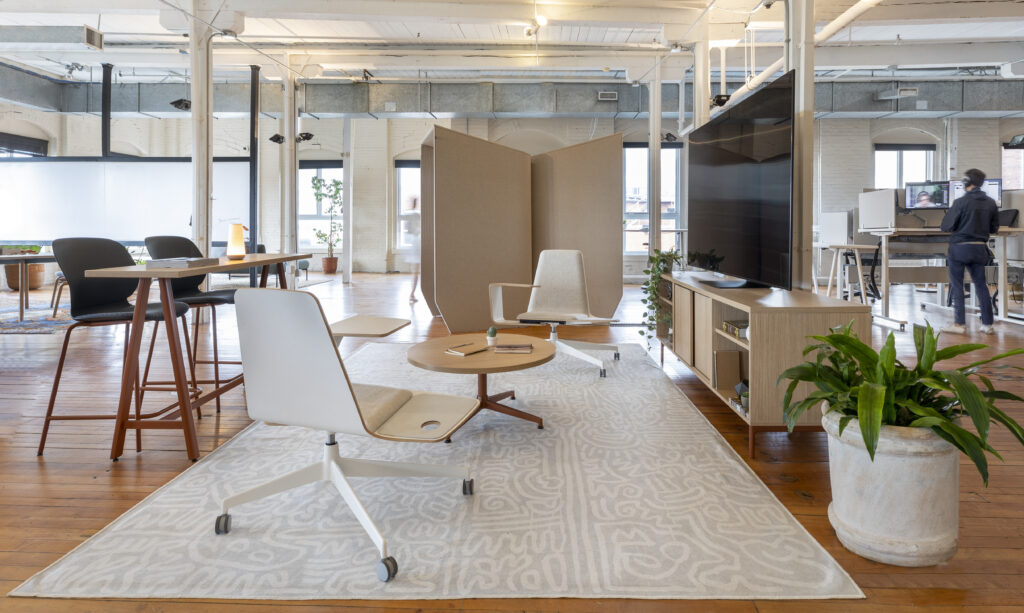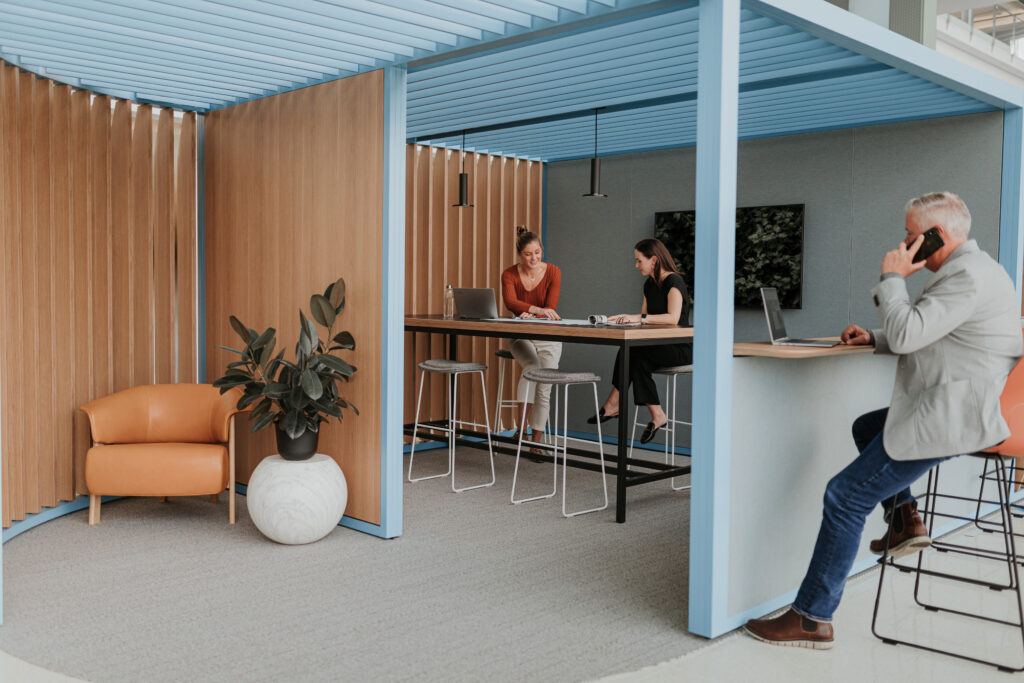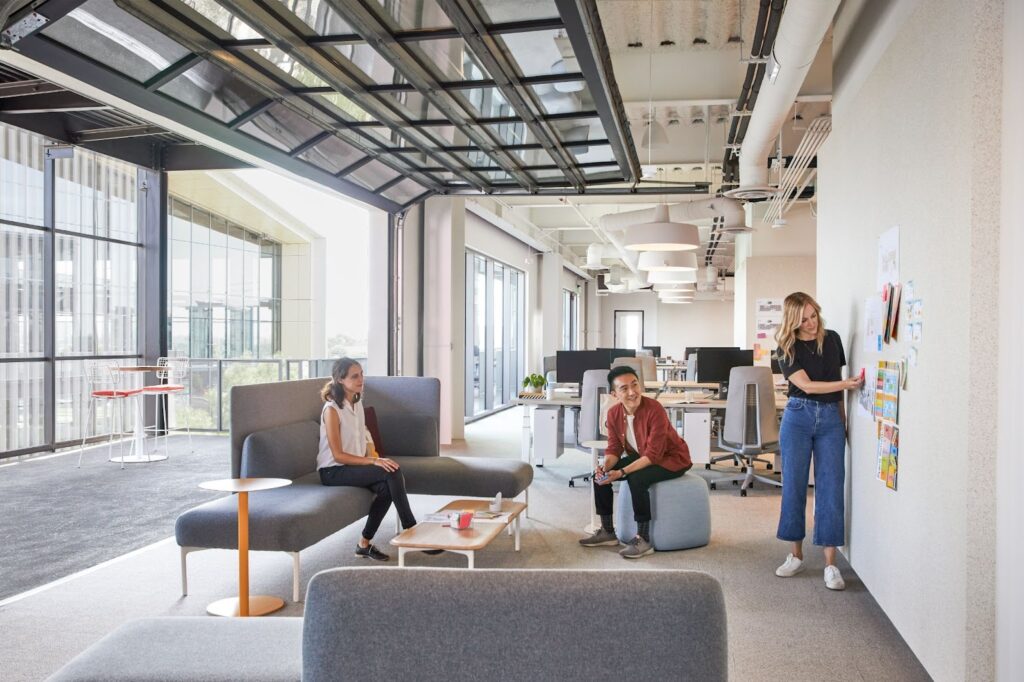Table Of Contents
Understanding Hybrid Workplace Strategy
The Role Of Hybrid Office Design
Converting Your Office into a Hybrid Work Environment
Technology Integration For Seamless Hybrid Work
Employee Engagement And Well-Being
Overcoming The Challenges of Hybrid Work Model Implementation
Hybrid offices. Let’s talk about them. This innovative concept represents a pivotal shift in the way businesses operate, with a focus on flexibility, adaptability, and the harmonious integration of remote and in-office work. For Midwest businesses seeking to navigate this new terrain, the journey begins with the thoughtful design of their physical office.
With over 25 years of experience in helping Columbus-based businesses evolve their offices to sustain efficiency and employee wellness, King Business Interiors has taken our best practices and most successful methods to address one of our most asked questions: how do I redesign my office for hybrid work? Read on to learn the intricacies of full-proof hybrid office design, offering insights, inspiration, and actionable steps to make this transition as seamless as possible.
Understanding Hybrid Workplace Strategy

What is a hybrid workplace strategy?
The hybrid workplace strategy represents a deliberate and well-thought-out approach to balance remote and in-office work. It recognizes that employees have different workstyle preferences and seeks to accommodate them while maintaining productivity and collaboration. Key elements of this strategy include:
- Flexibility: Empowering employees to choose where and when they work, accommodating individual schedules and preferences.
- Technology Integration: Seamlessly integrating technology to support remote and in-office collaboration, ensuring everyone can connect and contribute effectively.
- Space Optimization: Reimagining the physical workspace to cater to both individual and collaborative work, fostering creativity and productivity.
Benefits Of Adopting A Hybrid Work Model
Embracing a hybrid workplace model offers a plethora of advantages for businesses in Columbus, OH:
- Enhanced Talent Attraction And Retention: Attract a wider talent pool by offering the flexibility that today’s workforce values. Retain top talent by accommodating their workstyle preferences.
- Cost Efficiency: Optimize the use of office space, potentially reducing real estate costs, while still maintaining a physical presence for essential activities.
- Increased Productivity: Allow employees to work where they feel most comfortable and productive, resulting in improved overall performance.
- Business Continuity: Establish a resilient workplace that can adapt to unforeseen circumstances, such as pandemics or natural disasters.
As we journey deeper into this guide, we will explore the intricate relationship between design and strategy, shedding light on how your physical workspace can be a driving force behind a successful hybrid workplace. Get ready to discover the art and science of creating a workspace that not only accommodates but also empowers your hybrid team.
The Role Of Hybrid Office Design
In the realm of crafting a successful hybrid office, design is not merely an aesthetic consideration but a strategic imperative. It plays a significant role in shaping a supportive and efficient environment for your business.
The Impact Of Office Design On Employee Productivity
Your office environment wields a profound influence on how your employees work and interact, and making informed design choices can reap numerous benefits for your business. As a key decision-maker, understanding this impact is crucial for unlocking the full potential of your workforce. To help you navigate this terrain, King Business Interiors specializes in hybrid office design. Our team can provide invaluable insights and expertise on how to improve the ebb and flow of your office in more ways than one:
- Spatial Attributes: It plays a pivotal role in shaping employee behavior, igniting creativity, and fostering well-being. The advantages extend to improved collaboration, heightened focus, and a more positive work atmosphere.
- Ergonomics: Recognizing the paramount importance of ergonomic furniture and layouts is key to enhancing comfort and productivity. Embracing ergonomic design can lead to a reduction in workplace injuries, an uptick in employee satisfaction, and a boost in overall efficiency.
- Biophilic Office Design: Prioritizing the integration of natural elements, including ample natural light, lush greenery, and inviting outdoor spaces, serves to elevate employee wellness. The benefits encompass enhanced mental health, reduced stress levels, and a deeper connection with the environment, all contributing to heightened productivity and job satisfaction.

Key Considerations For Hybrid Office Design Layout: Crafting A Harmonious Work Environment
Creating a hybrid office design layout is akin to conducting an intricate symphony of spaces that cater to a myriad of workstyles and activities.
- Flexible Workspaces: Embrace the concept of versatile workstations that seamlessly adapt to different tasks and employee preferences. This approach fosters a dynamic work environment where employees can easily shift between focused, collaborative, or creative tasks. The benefits include increased adaptability, improved utilization of space, and enhanced employee autonomy.
- Technology Integration: Explore how the seamless integration of technology can bridge the gap between remote and in-office workers, fostering collaboration regardless of physical location. By ensuring that the digital infrastructure supports effective communication and workflow, you enable teams to collaborate effortlessly and maintain productivity. The outcomes encompass improved connectivity, streamlined processes, and a cohesive work experience for all.
- Collaboration Zones: These areas should be thoughtfully designed with the right tools, ambiance, and furnishings to encourage teamwork and brainstorming sessions. Creating spaces that facilitate spontaneous interactions and idea exchange can lead to increased innovation, stronger team bonds, and a more vibrant office culture.
- Employee Well-being Spaces: Examine the integration of wellness areas, quiet zones, and relaxation spaces to support employee physical and mental health. Such spaces provide employees with opportunities to recharge, destress, and maintain a healthy work-life balance. The benefits encompass enhanced employee morale, reduced burnout, and increased overall well-being, ultimately contributing to higher productivity and job satisfaction.
Incorporating these considerations into your hybrid office design ensures that your workplace becomes a harmonious and productive ecosystem, where employees can thrive, collaborate, and find balance in their work lives.
Converting Your Office into a Hybrid Work Environment
Embarking on a journey toward a hybrid workplace is a transformative process. It requires meticulous planning and execution to ensure a smooth transition that benefits both your bottom line and your employees.
Assessing Your Current Office Space
Before making any changes, it’s imperative to understand your starting point. Consider conducting a comprehensive assessment that covers:
- Space Utilization: Evaluate how your existing office space is currently being used and identify underutilized areas.
- Technology Infrastructure: Assess the state of your technology infrastructure and identify any gaps or upgrades required to support a hybrid model.
- Employee Feedback: Seek input from your employees to understand their needs, preferences, and concerns regarding the transition.
Need help getting started? Request an appointment with our design team to get a custom assessment of your office.
Identifying Necessary Changes And Upgrades
Once you’ve gathered data, it’s time to pinpoint the changes and upgrades needed to transform your workspace into a hybrid haven:
- Design Consultation: Collaborate with commercial interior design experts to develop a layout that aligns with your hybrid workplace strategy.
- Furniture Procurement: Source furniture that facilitates the desired workstyles, collaboration methods.
- Managing Acoustics: With the assistance of our sound masking partner, analysis can be made to help manage distractions from noise.
Budgeting For The Transition
Budgetary considerations are a critical aspect of any workplace transformation. King guides you through the budgeting process by addressing:
- Cost Allocation: Determine a budget allocation for design, furniture, technology, and any necessary renovations.
- ROI Analysis: Explore how investments in your hybrid workplace will yield returns through increased productivity, employee satisfaction, and business continuity.
Building A Timeline For Implementation
Successful execution of your hybrid workplace transition requires a well-defined timeline. We outline steps to help you create a timeline that ensures a seamless shift:
- Phased Implementation: Consider a phased approach to minimize disruptions and allow for adjustments based on feedback. This approach is especially common for businesses that are transitioning from fully remote work to a hybrid model within the next year.
- Employee Training: Allocate time for training employees in new technologies and workplace guidelines. This training is particularly beneficial for employees hired within the last three years who may not have prior in-office experience with your company.
As you embark on the journey of transforming your office into a hybrid haven, remember that careful planning and attention to detail are the keys to success.
Technology Integration For Seamless Hybrid Work
Technology serves as the cornerstone of a thriving hybrid workplace, functioning as the bridge that connects your in-office and remote employees. This connectivity ensures effective collaboration, seamless communication, and access to essential resources. Without this foundation, the prospects of success for your hybrid office endeavor are significantly diminished.
Leveraging Technology to Support Remote and In-Office Employees
Collaboration Tools
In a hybrid workplace, collaboration is essential. Embrace digital collaboration tools like Slack, Microsoft Teams, or Zoom to facilitate real-time communication, file sharing, and video conferencing. These platforms create a virtual office space where your team can connect, brainstorm, and collaborate as if they were in the same room.

Unified Communications
Implement unified communication systems that bring together voice, video, and messaging in a single platform. This not only simplifies communication but also enhances productivity by reducing the time spent switching between different tools.
Employee Engagement And Well-Being
While the physical workspace and technology are critical components of a successful hybrid workplace, it’s equally essential to prioritize the engagement and well-being of your employees.
Fostering A Sense Of Belonging Among Hybrid Workers
- Virtual Social Activities: In a hybrid work setting, it’s crucial to find innovative ways to foster a sense of belonging among your employees. Organize virtual team-building activities, such as virtual happy hours, online games, or collaborative projects that encourage interaction and camaraderie among remote and in-office workers!
- Transparent Communication: Effective communication is the backbone of any successful organization. Maintain transparent and regular communication channels to keep all employees, regardless of their work location, engaged and informed. Regular updates, town hall meetings, and open forums can help bridge communication gaps.
Strategies For Maintaining Company Culture
- Culture Integration: As your workforce becomes more dispersed, maintaining your company’s culture becomes paramount. Ensure that your company’s values, mission, and culture are not lost in translation. Develop initiatives that emphasize these values and encourage employees to embody them in their daily work, whether they’re at home or in the office.
- Leadership Role: Leadership plays a critical role in preserving and promoting company culture. Leaders should lead by example, demonstrating the desired cultural traits and values. Encourage leaders to engage with remote employees regularly and actively participate in virtual events to show their commitment to the company’s culture.
Promoting Physical And Mental Well-Being In A Hybrid Environment
- Wellness Initiatives: Prioritize the physical and mental health of your employees. Offer wellness programs and initiatives that support well-being, such as yoga classes, mental health workshops, or fitness challenges. Consider providing wellness stipends or subscriptions to mental health apps to support remote workers’ well-being.
- Flexible Work Hours: One of the advantages of a hybrid workplace is flexibility. Encourage employees to set their own work hours within certain limits. This flexibility can help individuals manage their personal lives and work responsibilities more effectively, reducing stress and improving overall well-being.
- Ergonomic Support: Ensure that both office and remote employees have access to ergonomic furniture and equipment. Ergonomically designed workstations promote physical well-being by reducing the risk of musculoskeletal issues associated with extended hours of work.
By prioritizing employee engagement and well-being in your hybrid workplace strategy, you not only create a more inclusive and supportive environment but also contribute to the overall success and satisfaction of your workforce. Engaged and healthy employees are more likely to be productive, innovative, and committed to the organization’s goals, making them valuable assets in the journey towards a thriving hybrid workplace.
Overcoming Challenges in Hybrid Model Implementation
Transitioning to a hybrid workplace model comes with its fair share of challenges, but with careful planning and effective strategies, these obstacles can be surmounted.
Addressing Common Obstacles in the Transition
- Resistance to Change: Understand that change can be met with resistance. Communicate the benefits of the hybrid workplace clearly, addressing concerns and misconceptions. Offer training and resources to help employees adapt to new workflows and technologies.
- Embracing new habits: An overlooked hurdle to new Hybrid work place design is not changing old workstyle habits. If as a leader in your company you go into your office and spend a significant amount of time working from your desk you can expect your work team to follow your lead. If you truly wish to see a cultural shift in embracing hybrid work environments no other advice is better that “lead by example.” Your team will follow the pattern you model. The investment in new hybrid design will quickly become apparent to you as well if you shift locations from open collaboration zones to heads down focus space.
Strategies for Effective Change Management
- Change Communication: Effective communication is pivotal during the transition. Develop a comprehensive communication plan that includes regular updates, Q&A sessions, and feedback channels. Transparency helps build trust and keeps employees informed.
- Training and Support: Offer training sessions and resources to empower employees to use new technologies and navigate the hybrid work environment effectively. Ensure that employees have access to help and support whenever they need it.

Measuring Success and Making Continuous Improvements
- Key Performance Indicators (KPIs): Define measurable KPIs to evaluate the success of your hybrid workplace strategy. Metrics might include employee productivity, engagement levels, cost savings, or customer satisfaction. Regularly analyze these metrics to gauge progress.
- Feedback Loops: Establish feedback mechanisms that allow employees to share their experiences and suggestions. Act on this feedback to make continuous improvements. Employee input is invaluable in shaping and refining your hybrid workplace strategy.
Make Your Hybrid Workspace Happen: Schedule a Tailored Design Consultation Today!
Embracing the hybrid workplace model unlocks endless opportunities for success – both in your business and for employees. Remember the importance of flexibility, design, and technology. A thoughtful transition plan and cybersecurity measures are also crucial throughout the process. Prioritizing employee engagement, well-being, and change management leads to long-term success. With these insights, you’re ready to create a thriving, adaptable hybrid workplace that meets both organizational and employee needs.
Ready to transform your workspace into a tailored hybrid office? Schedule a consultation with King Business Interiors’ design team today and embark on your journey to a more productive and innovative workplace!
"*" indicates required fields



